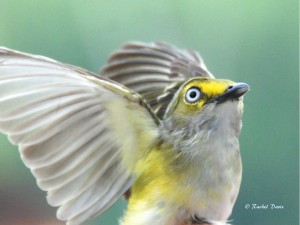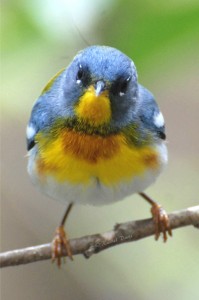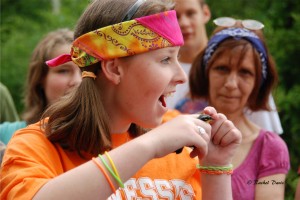
Like the neo-tropical migrants they come to see, guests for the annual New River Birding & Nature Festival travel thousands of miles on their appointed spring rounds. Entering their 12th year of operation, festival organizers have hosted participants from 46 of the 50 states (the Dakotas, Alaska and Hawaii being the missing parts) and from two foreign countries (Canada and New Zealand). The result is an event which contributes an excess of $100,000 into the local economy on an annual basis, priceless good will for the State of West Virginia and the ever-spreading message that habitat preservation adds up to economic sense.
For decades, a small group of birding enthusiasts in Fayette County struggled with how to get the word out about the spectacular spring migration they witnessed each and every year. Armed with a study by the Cornell Lab of Ornithology, these Fayette faithful knew that West Virginia was critical nesting habitat for wood warblers and other neo-tropical migrants. The last remaining stands of relatively unbroken forest habitat on the east coast were not only a haven for colorful birds, like Cerulean Warbler, Magnolia Warbler, White-eyed Vireo, Scarlet Tanager and dozens of other equally brilliant species, but it was also a place well-heeled birders could be attracted to.

The catalyst of change from having well-intended ideas to actually putting them in motion came in 2001 when the county revisited its 21-year-old Comprehensive Plan. Dave Pollard, the county resource coordinator and core birder, broached the idea of an early spring event as a way to increase shoulder-season tourism activity. The idea was embraced by the public, and a “Migration Celebration” was identified as a Comprehensive Plan project.
“Obviously, we didn’t go from having a good idea to a $100,000 a year event in one fell swoop. We crawled first, sometimes backwards.
We had and still have an Elderhostel (now Road Scholar) component to the event that kept us afloat in the early years, which is a separate event that runs concurrently with the festival. It allows us to share guides between the two venues. It is hosted at Hawks Nest State Park and is more of a classroom environment, whereas the festival is more hardcore birding in the field,” says Pollard. “In building on that, we made some fantastic connections, ended up being named a Top 10 Event by Bird Watcher’s Digest, have been dubbed ‘The Costa Rica of North America,’ and, today nearly all of the best-known people in the birding world come to us asking if they can be a part of our guide staff. And the birders flock to those guides and have a wonderful time spending their money here.”

Sally Bays, a resident from Maryland’s eastern shore is a festival patron who attends the event each year along with her husband, five children and mother. In summing up the back-porch culture and habitat preservation message the festival promotes, Bays says, “It’s a huge subculture of geeky, awesome people. It teaches the kids that they can be totally counterculture and be successful and awesome and happy.”
Pollard is quick to point out that habitat preservation in the New River style is not out of step with traditional Southern West Virginia lifestyles and the resource extraction industries that are a big part of people’s lives. “Some of the best birding we have is done on old strip mine sites and in relatively new forest cuts,” he says. “The Golden-winged Warbler, which is a spectacular bird, is fast disappearing, but Southern West Virginia is one of the few places having a stronghold of these birds. Broken canopies and resultant scrub growth form the habitat they need, and the strip mining and timber industries have done a good job of providing this habitat. From talking to people in these industries, they do so gladly and conscientiously. Now I’m not saying that we don’t need to keep a close eye on these activities because we certainly do. However, with moderation and reasonable control, the birds, the people who watch them and those who make their living off of trees and coal can continue to coexist.
“I can remember when my daughter was about 10 years old and she got a great look at her first Yellow-throated Warbler. The only word she could muster was ‘Wow!’ She went on to do a captive raptor management program at Cornell while in high school, interned a summer with Three Rivers Avian Center, and now she is in school pursuing her doctorate in veterinary medicine. That is what birds can do for you, and it is the message we send out at the New River Birding & Nature Festival. When our guest go back home, they take that message and a very fond impression of West Virginia with them,” says Pollard.
About the Authors

This piece was a collaborative effort thanks to the staff and guides of the New River Birding & Nature Festival. While the New River Birding & Nature Festival is a signature event in terms of promoting West Virginia, it is just a piece of an intricate puzzle put together by the Fayette County Education Fund. A 501 (c)(3) organization, the fund dedicates itself to environmental and youth education through a wide range of venues.
The birding festival held each year during the last week of April and first week of May, is just one of three events hosted by the organization. The New River Hummingbird Festival, held in August, dedicates itself to the study of West Virginia’s only resident hummingbird species, the Ruby-throated Hummingbird. In October the group hosts Fall Birding Weekend focused on raptor migration and the identification of fall warblers.
To learn more about the Fayette County Education Fund, its events and programs, visit birding-wv.com and on Facebook at: LeadershipFayetteCounty and NewRiverBirdingNatureCenter.








